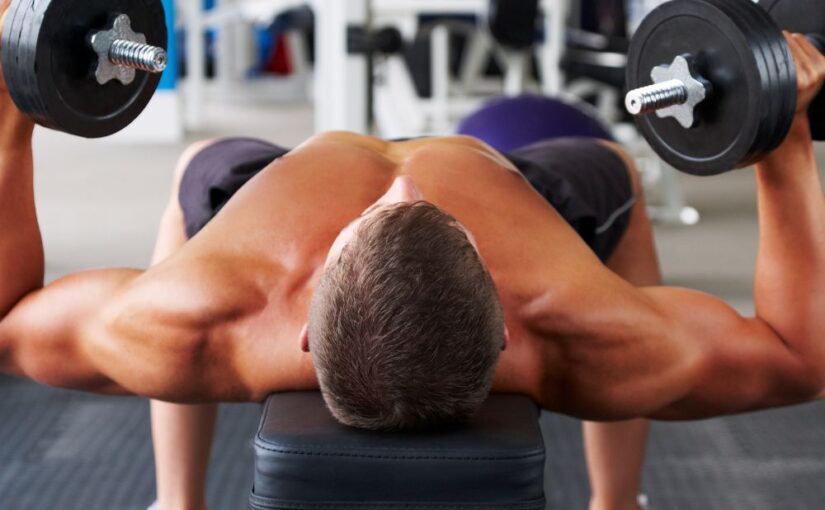If you’ve been strength training for a while, you’ve likely noticed a significant difference in the amount of weight you can lift when comparing the dumbbell and barbell bench press variations. Many lifters find they can press substantially more weight with a barbell than with dumbbells. This often raises the question: Why is my dumbbell bench press weaker than my barbell bench press?
This difference is common and understandable when considering the biomechanical, neurological, and psychological demands of each variation. Both the dumbbell and barbell bench press target the same primary muscle groups—chiefly the chest, triceps, and shoulders—but the physical demands they place on your body vary greatly. Dumbbells require each side of your body to work independently, placing higher demands on stability, coordination, and muscular control. Barbells, on the other hand, allow the stronger side to compensate for the weaker one and provide a more stable platform, enabling heavier lifts.
The disparity between the dumbbell and barbell bench press isn’t just about raw strength—it’s about how well your body controls and coordinates movement, your experience with each tool, and even how comfortable or confident you feel performing the lift. In this article, we’ll break down the reasons your dumbbell press might lag behind your barbell numbers and offer actionable steps to bring both into alignment.
1. Stability Differences
One of the primary differences between the dumbbell and barbell bench press is stability. Barbells offer a mechanically stable path of motion. Since your hands are connected by a solid bar, the barbell locks your arms into a fixed plane. This allows you to generate force more efficiently, even if your technique isn’t perfect. The shared control across both arms helps reduce the workload on your stabilizing muscles.
Dumbbells remove that built-in support. Each arm must work independently, and your body must actively stabilize each dumbbell throughout the entire range of motion. This increases the demand on your rotator cuff, scapular stabilizers, forearms, and even your core. If those smaller stabilizing muscles aren’t well-developed, your performance with dumbbells will suffer. You may fatigue faster and be less capable of pushing close to your max, even if your chest and triceps are strong.
This lack of stability also impacts the bar path. With barbells, the motion is predictable—usually straight up and down over your mid-chest. With dumbbells, the natural path is more of an arc. Without the guiding structure of the bar, even a slight misalignment can throw off the entire lift. Your nervous system senses this and may limit your force output to protect you from injury.
In short, barbells allow you to “muscle through” more weight, while dumbbells expose weaknesses in control and coordination. This is why stability is a key factor in why your dumbbell bench press feels weaker, even though it might provide a more comprehensive workout.
2. Comparing the Range of Motion
Another major reason for the difference between the dumbbell and barbell bench press is range of motion (ROM). Barbells, due to their structure, limit how deep you can go during a press. Once the bar touches your chest, you’ve reached the end of the movement. While effective for building strength, this restricted ROM activates fewer muscle fibers, particularly in the lower chest and shoulders.
Dumbbells, in contrast, enable you to lower the weights to a greater depth. Without the restriction of a fixed bar, your arms can drop below chest level. This deeper range of motion stretches the chest muscles more fully and engages more muscle fibers, particularly in the pectoralis major and minor. The increased stretch leads to greater muscle activation and more time under tension—both essential for hypertrophy (muscle growth). However, this also makes the movement more challenging, especially at the bottom of the lift.
Additionally, dumbbells let your hands come closer together at the top of the lift, promoting a better peak contraction in the chest. This fluid motion mimics the natural path of your shoulder joint, making it a more joint-friendly lift in many cases. However, the greater range of motion places more demand on your stabilizers and increases the risk of form breakdown, particularly under heavier loads.
In essence, dumbbells require you to work through a deeper and longer range of motion. While this is excellent for muscle growth, it makes the movement harder—one reason lifters often find the dumbbell press more difficult and can’t lift as heavy compared to its barbell counterpart.
3. Muscle Activation in Dumbbell vs. Barbell Pressing
One of the most significant differences in muscle recruitment between the dumbbell and barbell bench press lies in the type of muscle activation. Both exercises primarily target the chest, shoulders, and triceps, but the degree and type of muscle engagement differ.
With a barbell, most of the workload falls on the large prime movers—especially the pectoralis major, anterior deltoid, and triceps brachii. Because the barbell provides external stability, your nervous system can focus on generating maximal force through these larger muscles, enabling you to lift heavier weights and build maximal strength over time.
Dumbbells, however, shift the focus slightly by increasing the involvement of smaller stabilizing muscles. The rotator cuff (particularly the infraspinatus and supraspinatus), serratus anterior, and even the core muscles must work harder to control the independent movement of each arm. Your grip, wrist, and forearm strength also become limiting factors as you strive to keep the dumbbells aligned throughout the lift.
Another factor is unilateral loading. With dumbbells, each arm is responsible for lifting independently, which exposes any imbalances between your left and right sides. The stronger side can no longer compensate for the weaker side, as it can with a barbell. This may make dumbbell presses feel more challenging in the moment—especially if your non-dominant side is weaker—but it can lead to improved muscle symmetry over time.
In summary, barbell pressing emphasizes raw power, while dumbbell pressing promotes balanced, functional strength. While you may lift less weight with dumbbells, you’re engaging more muscles, particularly those that contribute to long-term stability and injury prevention.
4. Psychological Factors in Dumbbell vs. Barbell Bench Press
The psychological aspect of the dumbbell vs. barbell bench press is another important factor in why the dumbbell press often feels weaker. Barbells generally provide a greater sense of security. With safety bars or a spotter, you can push yourself more comfortably to heavier loads, knowing that the fixed bar will always move in a controlled direction. This can give you the mental confidence to press harder and attempt new personal records.
On the other hand, dumbbells introduce a degree of instability that can be intimidating—particularly if you lack a spotter or haven’t perfected your technique. The risk of dropping a dumbbell or losing control at the bottom of the lift can cause hesitation, limiting the amount of weight you’re willing to attempt. This mental barrier often causes lifters to hold back on their dumbbell presses, even if their bodies are capable of handling more.
In addition, getting set up for the dumbbell press can be more demanding. Kicking the dumbbells into position, balancing them while you get into proper form, and ensuring your grip is secure—especially as you fatigue—can be intimidating for lifters who aren’t used to this type of lift.
Overcoming these psychological challenges takes time and practice. Once you build confidence in your technique and ability to manage dumbbells safely, you’ll likely see a significant improvement in both your strength and performance.
5. Improving Dumbbell and Barbell Bench Press Techniques
The discrepancy between your dumbbell and barbell bench press can also stem from experience. Many lifters train the barbell bench press more frequently than the dumbbell press. Over time, repeated use of the barbell helps improve technique, neuromuscular adaptation, and muscle recruitment. The more you practice with the barbell, the more efficient your body becomes at lifting heavier weights.
Dumbbell pressing requires more technique, coordination, and precision. The movement is more complex because your arms operate independently, necessitating better control throughout the entire range of motion. You also need to engage smaller stabilizing muscles to prevent the dumbbells from wobbling, which demands more focus and effort.
If you don’t practice the dumbbell press as often as the barbell, it may feel unfamiliar and more difficult. However, with consistent practice and attention to proper form, your coordination and strength in the dumbbell press will improve.
Switching between the two movements while maintaining good form will help balance your muscle development and technique. It also helps prevent overuse injuries by varying the load on your muscles and joints.
6. Strengthening Dumbbell and Barbell Bench Press Performance
If the comparison between your dumbbell and barbell bench press is holding you back, don’t worry—improvement is possible. Here are a few strategies to help:
- Train both movements regularly – Incorporate both dumbbell and barbell bench press variations into your weekly routine for balanced development.
- Emphasize stability exercises – Build stabilizer muscles through movements like planks, face pulls, and shoulder rotations.
- Start with moderate weights – Begin with lighter weights to focus on form and control before progressing to heavier loads.
- Use unilateral training – Incorporate single-arm dumbbell presses to address strength imbalances between sides.
- Gradually increase weight – Slowly add weight to dumbbells as you gain confidence and stability in the lift.
Conclusion: Closing the Gap Between Dumbbell and Barbell Bench Press
In conclusion, the difference between your dumbbell and barbell bench press performances is due to differences in lifting mechanics. The barbell press offers more stability and allows for heavier lifting, while the dumbbell press requires more stabilizer activation and coordination, making it more challenging and potentially less powerful.
By focusing on developing your stabilizer muscles, refining your technique, and practicing both exercises regularly, you’ll likely see improvements in both your dumbbell and barbell bench press numbers. Incorporating both lifts into your training routine will lead to a more well-rounded chest and upper body strength, helping you break through plateaus and achieve better overall progress in your fitness journey.
Recommended Equipment for Your Dumbbell and Barbell Bench Press Workouts
To take your bench press training to the next level, having the right equipment can make a significant difference. If you’re in the market for some gear to help you out, check out the following options:
- Adjustable Dumbbells
Adjustable dumbbells offer great flexibility for strength training, allowing you to easily change the weight for different exercises. They are perfect for those who want to perform dumbbell bench presses without needing multiple pairs of dumbbells. Check out adjustable dumbbells on Amazon - Olympic Barbell
An Olympic barbell is the gold standard for bench pressing and other heavy lifts. Designed for durability and heavy loads, this barbell is essential for those who want to lift substantial weight and improve their overall strength. Explore Olympic barbells on Amazon - Weight Plates for Barbells
Weight plates are a must-have for anyone using a barbell in their workout. Whether you’re doing barbell bench presses or other strength exercises, investing in high-quality weight plates can help you safely increase your load and track your progress. Find weight plates for barbells on Amazon - Flat or Adjustable Weight Bench
A solid, adjustable weight bench is crucial for proper bench press form. Whether you’re performing flat, incline, or decline presses, an adjustable bench offers the versatility you need to target various muscle groups for a well-rounded chest workout. Discover adjustable weight benches on Amazon
Amazon Affiliate Disclaimer
This article contains affiliate links. If you choose to make a purchase through these links, we may earn a small commission at no additional cost to you. This helps us maintain and improve our website. Thank you for your support!

